Construction rework is the bane of every contractor's existence. No one wants to redo work that should have been done right the first time, but it happens all too often. In fact, studies reveal that construction rework can eat up to 6% of project budgets and lead to productivity losses as high as 300%. That's a massive hit, both financially and in terms of time wasted.
So how do you avoid this frustrating scenario? The answer lies in having a well-defined construction quality control plan from the start of your project. Not only does it save you from the pain of costly reworks, but it also:
- Sets a clear standard for quality expectations, making sure everyone’s on the same page.
- Creates a paper trail of the entire quality control process, from inspections to tests and corrective actions.
- Helps anticipate potential problems and outlines steps to fix them.
This guide provides a quality control plan construction template you can implement immediately. It also walks you through creating a comprehensive plan tailored to your projects.
Note: Quality control templates give you a solid foundation for running your project to the highest standards. But that's just one way to simplify your construction process. Downtobid takes it a step further by identifying scopes within your construction plans, connecting you with qualified subcontractors, and helping you send personalized ITBs that get higher response rates. Give the platform a try for free today and see how it can make your project run smoother.
Key Takeaways
- Quality control plans prevent rework costing 6% of budgets and 300% productivity losses.
- Template includes introduction, team roles, scope definition, inspection/testing procedures.
- Quality control catches defects; quality assurance prevents them through process improvement.
- Establishes standards, creates documentation, anticipates problems, outlines corrective actions.
- Downtobid's AI identifies scopes in minutes, connects subcontractors with 60%+ response rates.
What is a Construction Quality Control Plan?
A construction quality control plan (CQCP) outlines how your construction team plans to meet and exceed the quality standards expected by clients and regulators. It keeps three critical elements in check: quality, time, and cost. It does this by:
- Tracking progress with regular checks to make sure the project stays on schedule. If something’s off, you can adjust workflows to stay on track.
- Establishing precise acceptance criteria the project should meet, which often leads to a higher-quality final product.
- Ensuring quality standards are met from the outset, reducing waste and saving on material, labor, and even preconstruction costs. This helps keep construction projects within financial limits while still meeting quality expectations.
Now, let's clarify a common mix-up: quality control and quality assurance. Although they’re often used interchangeably, they focus on different things:
- Quality control: A reactive process, it involves fulfilling predefined quality standards or requirements and aims to catch and correct quality issues before they impact the project.
- Quality Assurance: A proactive process, it focuses on providing confidence that the predefined quality standards and conditions are met, improving and optimizing construction processes to prevent defects or mistakes.
How to Use the Quality Control Plan Construction Template
Our template is designed to help you outline and implement quality control measures systematically. It:
- Ensures every aspect of the project is addressed, promoting higher workmanship and material quality.
- Offers a standard format you can tweak to fit your project’s specific needs, making plan creation quicker and easier.
- Provides a blueprint for maintaining quality throughout the project lifecycle, leading to a more consistent approach to quality management. Follow our project plan example and add the quality control plan.
You can access and copy the free quality control plan template here. Remember, this template is just a general guide, so you'll need to adjust specific details based on your actual project requirements, materials, and local regulations.
But before you start using the template, let's cover some crucial elements you need to get right from the outset.
Outline a Clear Introduction and Overview
Begin your quality control plan with a concise introduction that outlines its purpose and objectives. This section ensures both your team and the client clearly understand the project’s goals.
In this overview, briefly touch on:
- Project details
- Client and project specifications
- Key quality objectives
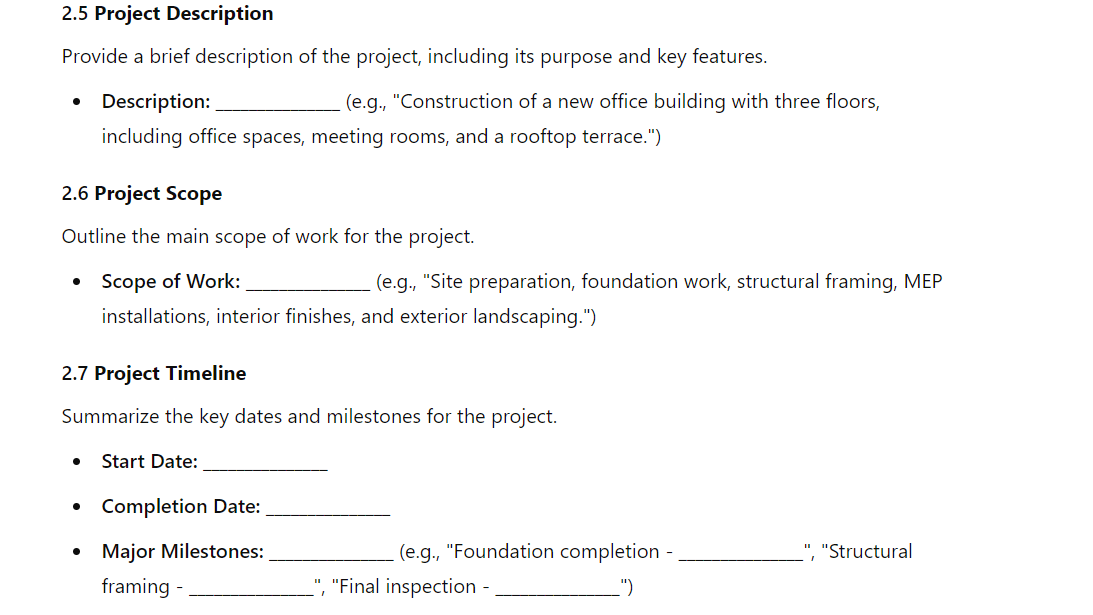
You'll explain the granular details in the next sections, so for now, keep it broad and focused.
Clarify Your Team’s Roles and Responsibilities
Quality control isn’t a one-person job. It is a collective effort, involving various participants who each play a crucial role in maintaining high standards.
However, you do need someone to lead the charge: a quality control manager. This person oversees all quality management work and handles day-to-day field operations. Your construction quality control plan should clearly define their responsibilities and how they collaborate with the rest of the team.
Once you've nailed down who the quality control manager is, create a detailed responsibilities list. This list acts as a handy reference for everyone involved and includes general duties like preparing, approving, and implementing the quality control plan, keeping documents in order, verifying materials, and more.
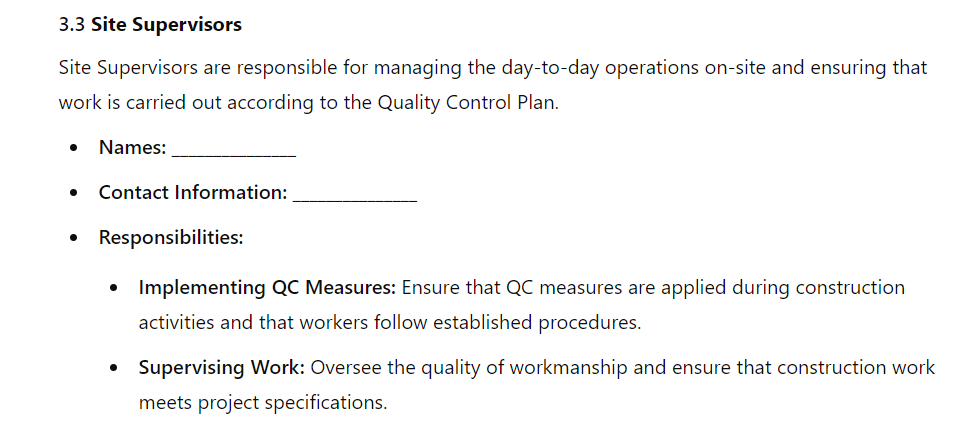
Also, include a Stop Work Authorization Letter. This letter, signed by the owner or stakeholders, gives the manager the authority to halt work if it doesn’t meet quality control standards or if materials don’t pass inspection.
Clearly Define the Scope of Work
A well-defined scope of work in construction helps you track progress, stay on course, and spot any quality control issue before it becomes a major problem. Outlining specific tasks and responsibilities through the SOW means you can effectively plan and allocate resources and ensure the right materials, equipment, and personnel are available when needed.
Start by clearly stating what the project aims to achieve. This includes its functionality, aesthetics, and compliance with regulations and building codes. Make sure everyone understands what’s expected in terms of results.
Next, specify the tangible outputs of the project. This could be structures, systems, or any other components that will be delivered upon completion. Each deliverable should be measurable and linked to the overall project goals. For a better idea, check out our construction project scope template.
Finally, break down the project into specific tasks and activities. Cover everything from site preparation to final inspection to make sure nothing slips through the cracks. A work breakdown structure (WBS) can make a big difference here. It organizes your project into a hierarchical structure, providing a clear and comprehensive view of the work required to complete the project. Our free project WBS template can give you a head start in organizing your project tasks.
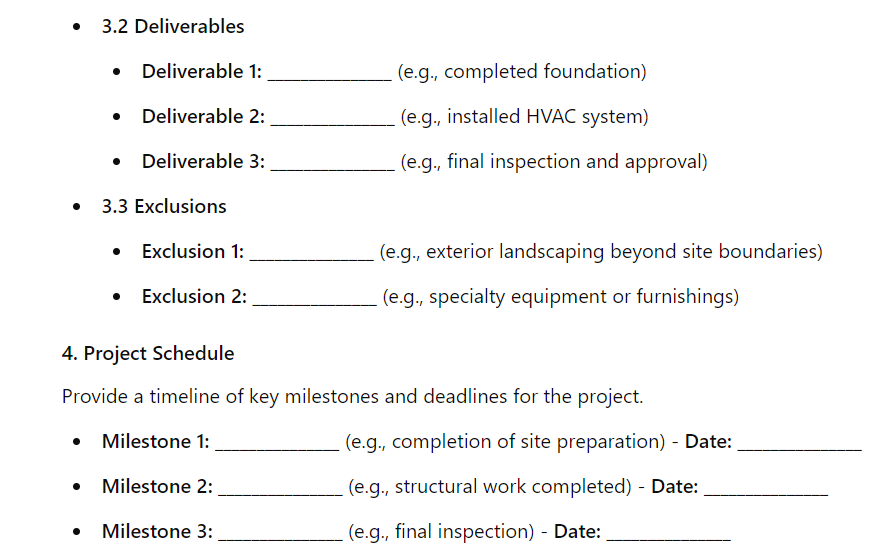
For a more efficient approach to scoping your work, consider using a platform like Downtobid. Our platform uses AI to sift through complex construction plans and identify potential scopes. This can save you hours you’d otherwise spend scanning over hundreds of complex blueprints. You can upload your plans (for free), and in minutes, the AI will find possible scopes and bid packages.
For example, in a recent Discount Tire project, the AI processed over 40 plan sheets in about six minutes. It:
- Identified 31 potential scopes
- Provided summary outlines for each scope
- Highlighted relevant details directly on the drawings
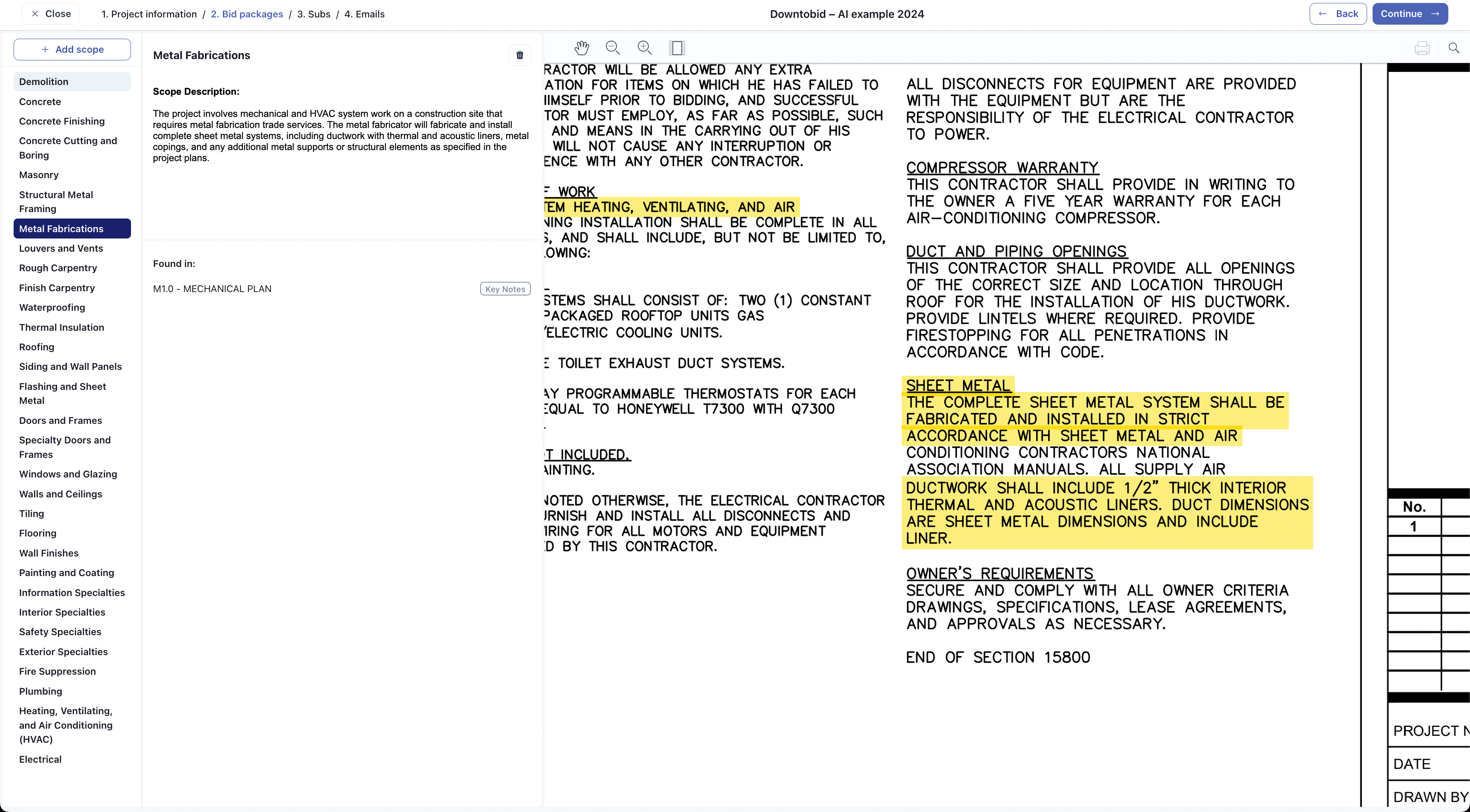
While the AI might flag some false positives, it provides a solid starting point, allowing you to focus on what truly matters for your construction project.
Map Out the Inspection, Testing, and Verification Phases
The final section of your construction quality control plan covers a lot of important ground. It details everything from testing and verification to submittals and tracking. Here's what you'll need to include:
- Inspection procedures: Often, there are preconstruction meetings before certain elements are built to go over specifications, crews, and more. Typically, high-quality projects have inspection phases: preparatory meetings, initial inspection, and follow-up inspection.
- Quality Control testing and verification: Outline the tests that will be conducted and specify the timeframe the quality control manager needs to give before each test. Make it clear what happens if a test fails—will there be a re-test or corrective action? Also Include how and where test records will be stored.
- Submittals: Describe the procedures for handling submittals. This includes what should happen if a submittal isn’t approved and the steps to follow if it is. Specify where submittals will be kept to ensure they’re easy to access and track.
- Tracking issues: Define what constitutes deficiencies and issues, and outline how the project managers will address them.
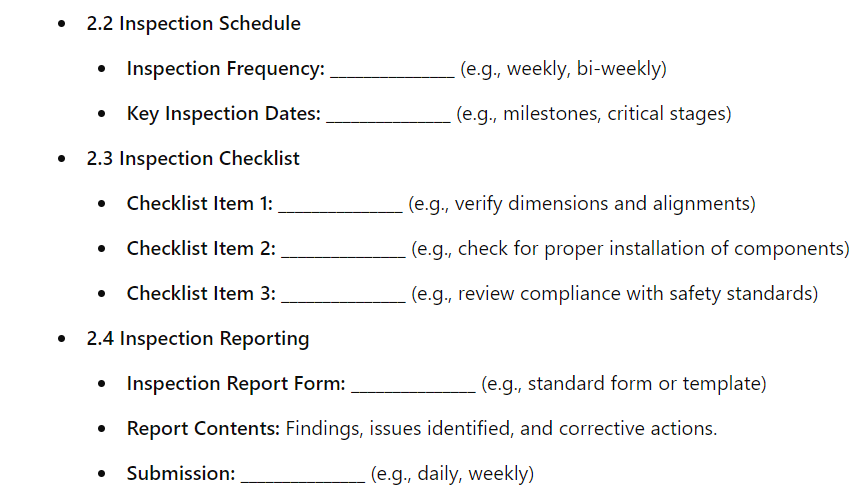
Establishing these quality control procedures helps keep everything running smoothly, ensures high standards are maintained throughout the project, and provides a basis for continuous improvement quality-related processes.
How Downtobid Can Take Your Construction Project to the Next Level
A quality control plan ensures your project meets quality standards, but there’s an equally important step before work even begins: assembling the right, qualified team for the job. Quality work starts with a quality team; fortunately for you, Downtobid can help streamline this process.
We've mentioned how you only need to upload your project documents, and our AI will help you find potential scopes in your project. But it goes further than that. Our AI also provides you with a curated list of local, qualified subcontractors you can invite to your project. Whether you're expanding into new territory or your usual team is stretched thin, you can still find the right subs to get the job done right.
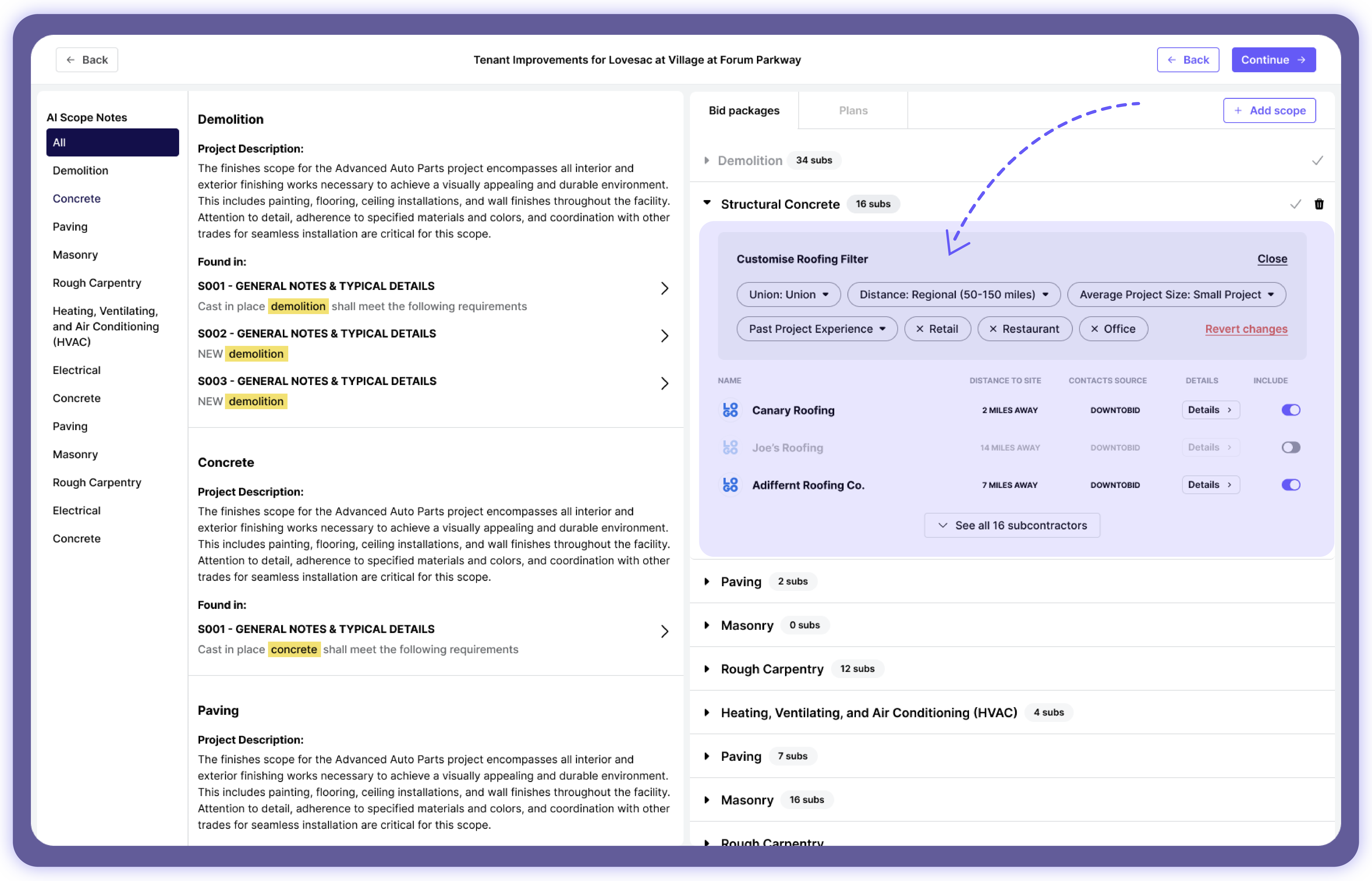
Our platform also allows you to send personalized ITBs, fostering genuine relationships with subcontractors from the start.
In fact, our users have seen impressive results with this approach. Some report over a 60% response rate to bid invitations and more than 80 bids for a single project.
Try our platform for free today to experience similar results.